Haptic Feedback Suits: The Complete Guide to Immersive Wearables
Updated On: November 13, 2025 by Aaron Connolly
What Are Haptic Feedback Suits?
Haptic feedback suits are wearable devices that bring physical sensations to your body while you’re gaming. You actually feel explosions, impacts, and even weather effects in real time.
These gaming accessories use several feedback mechanisms to match what’s happening on screen with touch-based experiences. It’s wild how much it changes the vibe.
Definition and Purpose
A haptic suit is basically a wearable device for gaming that gives you tactile feedback, thanks to all sorts of tech built into the fabric or hardware. People call these things VR suits, tactile suits, or just gaming vests.
The main goal? To make games more immersive by adding the sense of touch to your usual visuals and sounds. If you take damage in a shooter, the suit hits you with a physical jolt right on your chest.
Walking through rain? You’ll feel gentle tapping across your body.
Key gaming applications include:
- Feeling weapon recoil and explosions
- Sensing things like wind or rain
- Experiencing car crashes or impacts in racing games
- Detecting which way damage is coming from in combat
You can use these suits with regular gaming setups or VR systems. They’re meant to connect you emotionally to your games through physical sensation.
Key Components
Modern haptic suits come packed with essential parts that work together to deliver those real-feel sensations. The main layer is usually a vest or full-body suit made from materials you won’t sweat to death in.
Primary hardware components:
- Actuators – Small motors that make things vibrate and move
- Sensors – Track your body position and what’s happening in the game
- Control unit – Handles signals from the game and triggers feedback
- Connectivity – Wireless or USB to link up with your gaming system
Manufacturers put actuators all over the torso, back, and arms to hit the main impact zones. Most suits offer 16 to 40 feedback points for detailed sensation mapping.
Batteries typically last 4 to 8 hours. You can recharge with a USB-C cable or a charging dock, so you’re not stuck mid-game.
Software integration handles the heavy lifting so the suit talks to your games and VR platforms automatically. For most supported games, setup is a breeze.
Haptic Feedback Explained
Haptic feedback uses touch to send info to your skin and muscles. The tech fires up your sensory receptors—pressure, vibration, even temperature changes.
Three main feedback types:
- Vibrotactile – Vibration motors for impacts and textures
- Force feedback – Mechanical systems apply pressure or resistance
- Electrical stimulation – Sends small pulses to your muscles
Most consumer suits stick with vibrotactile feedback. You get everything from soft taps to strong jolts, depending on the vibration pattern.
Some advanced suits mix and match feedback types for a more convincing feel. You might get both vibration and a bit of pressure when something smacks into you in-game.
The suit syncs game events to your body. Take a headshot? You’ll feel it at head level. Hear footsteps? You’ll sense them near your feet.
That spatial accuracy really keeps you locked into the action.
How Haptic Feedback Suits Work
Haptic suits use vibrotactile actuators, electrical stimulation, and smart software to turn digital actions into real-life sensations. You’ll feel touches, hits, and even temperature changes mapped right onto your body.
Core Technologies
Most haptic suits rely mainly on vibrotactile actuators—little motors that vibrate at different speeds and strengths.
The bHaptics TactSuit, for example, packs in 40 feedback points across your torso and arms. Each spot has its own actuator, so you get unique patterns.
Ultrasonic feedback is the newest trick. Companies like Ultraleap are working on ways to create mid-air sensations, so you don’t even need to touch the suit.
Some suits mix in:
- Vibrotactile motors for impacts
- Thermal bits for temperature
- Force feedback for resistance
The Teslasuit throws all of these into one package. It weighs about 3kg and connects wirelessly to your VR rig.
Electrical Stimulation Methods
EMS (Electrical Muscle Stimulation) brings the strongest sensations. It sends controlled electrical pulses to your muscles, making them contract.
Teslasuit uses EMS to mimic heavy impacts or strong forces. Get hit in a game? The suit zaps the right muscle group.
TENS (Transcutaneous Electrical Nerve Stimulation) gives you softer sensations, targeting nerves instead of muscles.
FES (Functional Electrical Stimulation) can even move your limbs for you. Some experimental suits use FES in training simulations to guide your hands.
Safety is a big deal with electrical stimulation. Most suits cap the power and have automatic shut-offs.
Types of Sensations Delivered
Haptic suits deliver five main types of sensations to boost immersion.
Impact feedback makes you feel hits, bumps, or strikes. In racing games, the suit recreates the feeling of crashes across your body.
Environmental effects like wind, rain, or explosions get mapped as vibrations that fit the scene.
Temperature changes are wild—you might feel a warm spot near a virtual fire or a chill in a snow level.
Texture simulation lets you sense rough, bumpy, or smooth surfaces. Advanced suits can even mimic stone or metal.
Directional feedback tells you where something’s coming from. If you’re shot from behind, you’ll feel it on your back.
Integration with Software
Haptic suits need special software to translate game events into physical sensations. Most brands offer SDKs for game developers.
Real-time processing makes sure feedback matches what’s happening on screen, with almost no delay.
Popular games like Half-Life: Alyx and Beat Saber already support haptic suits. The software maps game events to specific body locations.
Calibration tools let you tweak how strong the sensations are. You can set up different zones to suit your preferences.
Some suits use Bluetooth or WiFi to connect, so you’re not tangled up in wires.
Cross-platform compatibility is handy—you can use one suit across lots of games and VR systems. The software bridges the gap between different engines and your hardware.
Popular Haptic Suit Models
Three main companies dominate the haptic suit world, each with its own focus and price range. TESLASUIT brings pro-level training, bHaptics is all about gaming, and Shockwave aims for the budget crowd.
TESLASUIT
TESLASUIT is easily the most advanced haptic suit out there. It’s a full-body system built for professional training and enterprise, not really for your average gamer.
Key Features:
- Over 90 haptic feedback points all over your body
- Tracks biometrics like heart rate and stress
- Motion capture built in
- Simulates temperature
- Electrical muscle stimulation
The suit lands in the £10,000–15,000 range, so it’s mostly for businesses and training centers. Police and fire departments use TESLASUIT for super-realistic emergency training.
Medical schools use it for surgical practice—students can actually feel tissue resistance and the pressure of their tools.
TESLASUIT needs special software and trained staff to run. It’s definitely not for home gaming or casual VR.
bHaptics TactSuit
bHaptics TactSuit hits a sweet spot between features and gaming support. They’ve got a few models, like the TactSuit Pro, Air, and some basic vests.
TactSuit Specs:
- 32–40 haptic motors (depends on the model)
- Wireless connection
- Works with 250+ VR games
- Converts audio to haptics
- Battery lasts 6–8 hours
TactSuit Pro costs around £500–800, and the Air model goes for £300–500. Not cheap, but pretty reasonable for serious VR fans.
The audio-to-haptics feature is a game changer. You can feel feedback from any VR content, even if the game doesn’t officially support haptics.
The suits run with popular games like Half-Life: Alyx and Beat Saber. Setup is pretty quick—about 10 minutes with their app.
Shockwave VR Suit
Shockwave VR Suit is aimed at gamers who want haptic feedback without breaking the bank. It’s an entry-level option at £200–400.
Basic Features:
- 16 haptic points
- Compatible with most VR headsets
- Easy wireless setup
- 4–6 hour battery life
Shockwave focuses just on gaming, not pro applications. The build feels lighter than the high-end stuff, but the feedback is solid for the price.
We’d suggest this suit for casual VR players who want to dip their toes into haptics. It works with games like Pavlov VR and VRChat through community plugins.
The main drawback? Fewer supported games than bHaptics. Always check compatibility before buying for a specific title.
Haptic Feedback Technologies
Haptic feedback suits use three main types of tech to create sensations: vibration motors for basic touch, EMS systems that stimulate muscles, and TENS units that target nerves. Each one brings a different level of intensity and realism.
Vibration Motors
Vibration motors are everywhere in gaming suits right now. These tiny devices buzz by spinning weighted wheels at different speeds.
Most suits scatter vibration motors across your chest, back, and arms. They can go from soft taps to pretty strong hits. When you get shot in a game, the right motors fire up to show where it landed.
Basic vibration motors are cheap—around £5–15 each—so they’re easy for companies to include. They don’t use much power, so your battery lasts longer. The downside? They only deliver vibration, nothing fancy.
Advanced linear actuators are a step up. They give you more precise feedback, like different textures or pressures, not just buzzing. They cost more, but the realism is worth it if you’re picky.
bHaptics suits use arrays of vibration motors. Most players say it makes them feel way more connected to the action when explosions and hits translate to real sensations.
EMS (Electrical Muscle Stimulation)
EMS tech sends small electrical pulses right to your muscles, making them contract without you doing anything. This feels much stronger than simple vibration.
EMS suits use electrodes on your skin to send those signals. Swing a sword in VR? The suit can tense up your arm muscles, so it feels like you’re really moving something heavy.
Safety comes first with EMS. Modern suits have shut-offs and limit the current to keep you safe. You’ll usually have to do a health check before using EMS gear.
The feeling ranges from a light tingle to a strong muscle twitch. Most systems let you dial in the strength to your liking. Some folks find EMS a bit weird at first, but you get used to it.
EMS suits are pricier—usually £500–2000. They need more power and fancier controls, but the force feedback is on another level.
TENS (Transcutaneous Electrical Nerve Stimulation)
TENS units go after your nerves, not your muscles. They send electrical pulses through your skin to mess with pain signals and create different touch sensations.
Unlike EMS, TENS doesn’t make your muscles jump. Instead, you’ll get tingling, warmth, or pressure. That makes TENS more comfortable for long gaming sessions, but you still get realistic feedback.
TENS tech comes from medicine and has a solid safety record. It’s been used for pain relief for ages, so manufacturers know what’s safe.
TENS can mimic textures that vibration motors just can’t. Touch rough bark in VR? TENS can make it feel prickly and real. It’s also good for simulating temperature.
Most TENS-based suits mix in vibration motors for a full range of feedback. TENS handles the subtle stuff, and motors give you the big impacts.
Software and Compatibility
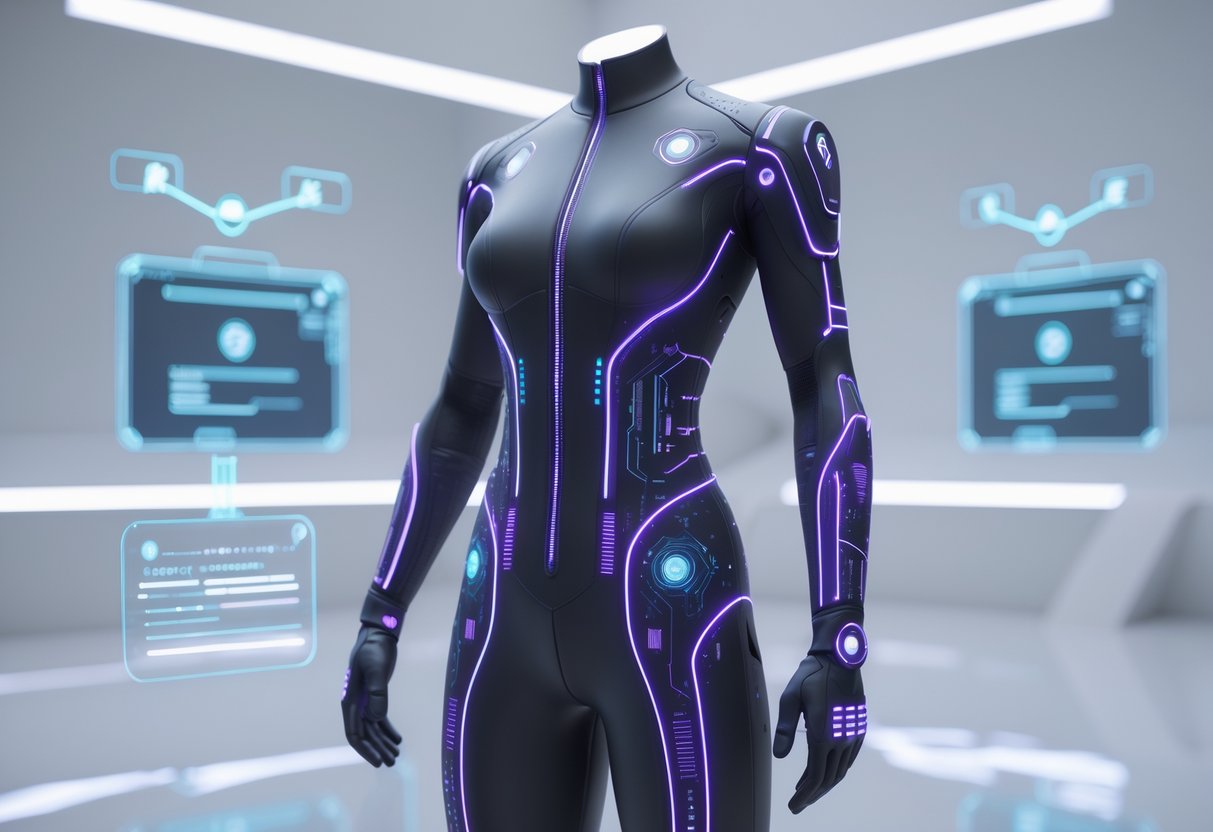
Haptic feedback suits need dedicated software to work with VR headsets and games. Most suits play nice with big platforms like Windows and Meta Quest, but game compatibility really depends on the brand.
Supported Platforms
Windows PC is still the go-to platform for haptic suits. Most manufacturers start by building their software for Windows systems.
The bHaptics Player runs on Windows, Meta Quest, iOS, and Android. That means you can try haptic feedback on a bunch of different devices.
Meta Quest compatibility has really taken off. Quest 2, Quest Pro, and Quest 3 all let you use haptic suits through their own apps.
Some brands focus on just one platform. TrueGear mostly aims at PC VR fans, while others—like Skinetic by Actronika—work with several systems.
Mobile support changes from brand to brand. You can get basic haptics on smartphones, but full-body suits need beefier hardware.
Game and App Integrations
Native game support makes a huge difference for haptic suits. When a game has built-in haptic features, the experience feels much better than just converting audio into feedback.
More VR titles now include haptic support. Loads of shooters, adventure games, and sims pick up haptic suits automatically.
Audio-to-haptic tech helps when games don’t have native support. This software turns game sounds into haptic patterns, but the results can be hit or miss.
The bHaptics ecosystem covers over 100 games and apps. You can check their compatibility list before you buy a suit.
Third-party software sometimes fills in the gaps. Mods and plugins from the community add haptic support to more games.
Customisable Experiences
Intensity controls let you tweak feedback strength for each body region. You can set different levels for your arms, chest, and back.
Most haptic software comes with pattern libraries full of ready-made effects. You can scroll through explosions, impacts, weather, and all sorts of sensations.
Device configuration tools help you get things running just right. You can test each feedback point and adjust the timing to your liking.
The bHaptics Player even has haptic worlds and demo content. These let you mess around with different feedback types and make sure your gear works.
Custom pattern creation is there for the tinkerers. Some software lets you build your own haptic effects, but you’ll need some technical know-how.
Full Body Immersion and Tracking

Modern haptic suits use motion capture systems to track your every move and bring them into virtual reality. These suits mix different sensor types with careful calibration to sync your avatar almost perfectly.
Motion Capture Capabilities
Full-body haptic suits track your movement with different sensor tech. The Teslasuit, for example, has motion capture built in, so it records your biomechanics while you move.
Most suits use inertial measurement units (IMUs) on key body parts. These sensors pick up rotation, acceleration, and direction. The system processes this data instantly to mirror your movements in VR.
Key tracking points include:
- Head and neck
- Shoulders and arms
- Torso and spine
- Hips and pelvis
- Legs and feet
High-end suits like the Shockwave use 12 trackers for full-body coverage. That means they catch even small movements, like your fingers or face.
You can export motion data in standard formats like CSV or FBX. Developers use this to link the tracking with engines like Unity 3D or Unreal Engine.
Avatar Synchronisation
Your real-life movements need to match your virtual avatar as closely as possible. Low-latency processing between suit sensors and your VR system is key. If there’s too much delay, everything feels off.
Most haptic suits connect wirelessly, so you don’t get tangled up. The bHaptics TactSuit uses wireless connections but still keeps tracking snappy. That way, you can move around naturally.
The system maps your body shape to the virtual character. Custom sizing options help make this mapping more accurate. Standard sizes work for most people, but custom measurements get you better alignment.
Synchronisation challenges include:
- Latency issues – Delays between your movement and the avatar’s response
- Drift problems – Sensors losing accuracy over time
- Occlusion effects – Body parts blocking sensor signals
Recalibrating regularly helps keep everything in sync during long VR sessions.
Sensor Placement and Calibration
Good sensor placement is crucial for tracking accuracy. Haptic suits put sensors at spots where movement is predictable. These spots serve as reliable reference points for the system.
Calibration usually means doing certain poses and movements. You’ll often stand in a T-pose, rotate your arms, and walk around. This lets the suit learn your body and how you move.
Most suits need calibration before each use. Stuff like magnetic interference can mess with the sensors. Metal, electronics, and wireless gadgets nearby can throw things off.
Calibration steps usually include:
- Standing reference pose – Sets your neutral position
- Range of motion tests – Maps how far you can move
- Walking patterns – Tunes leg and hip tracking
- Arm movements – Sets up shoulders and elbows
Some pro setups use external cameras to double-check accuracy. These optical systems can fix drift issues on the fly.
Comfort, Fit, and Materials
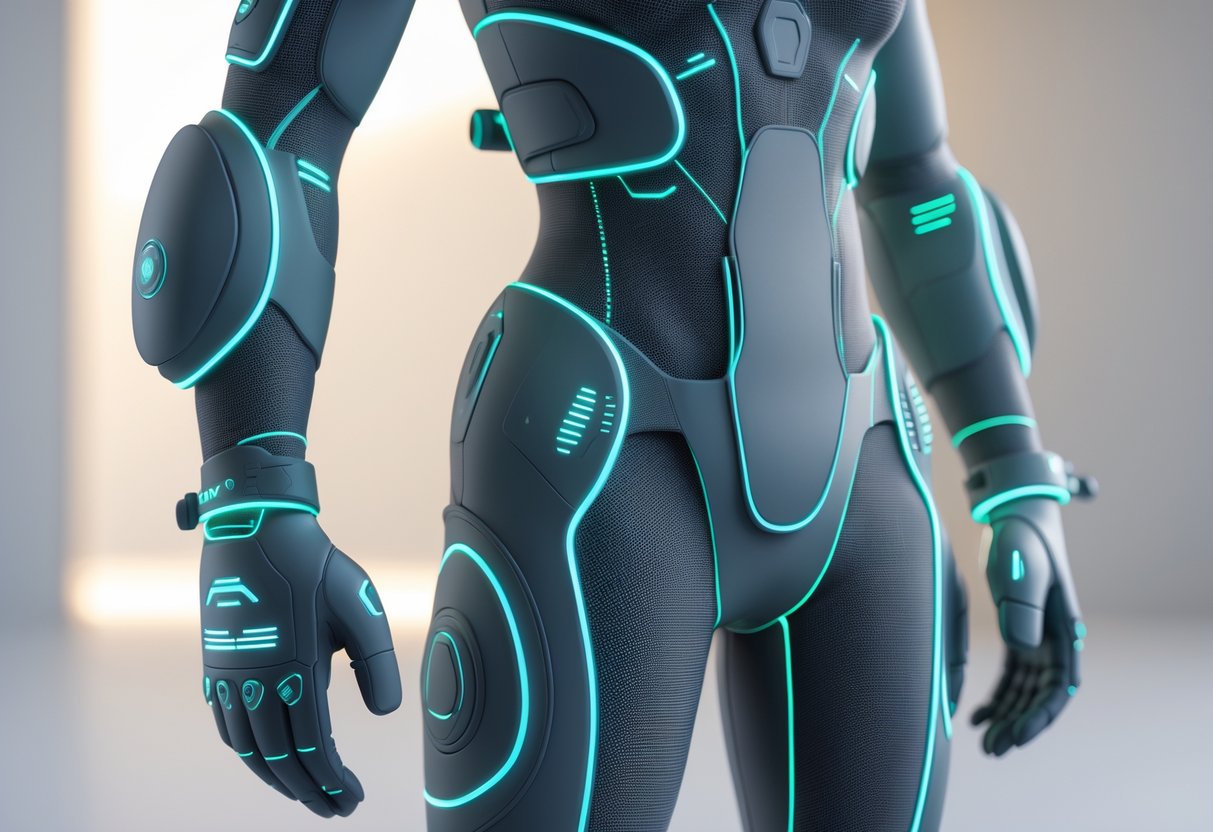
A great haptic suit should feel like a second skin and still deliver spot-on feedback, even during long gaming sessions. The best ones use stretchy materials, smart sizing, and are easy to care for.
Suit Design and Construction
Modern haptic suits use smart textiles that move and breathe with you. TESLASUIT, for example, has a two-piece setup—jacket and pants—that fits snugly thanks to stretchable, breathable fabrics.
Most suits put feedback motors in smart spots across your torso and limbs. The bHaptics TactSuit, for instance, spreads 32–40 motors throughout the vest to cover your main muscle groups.
Key construction features include:
- USB-C connectors for power
- Washable smart fabrics
- Motors placed on major muscle groups
- Lightweight build to avoid fatigue
The materials need to carry electrical signals for feedback but still feel comfy. Good suits avoid bulky wires that dig in while you move.
Adjustability and Sizing Options
Haptic suits come in sizes from XS to XXL for both men and women. The bHaptics vest uses an adjustable, magnetic pull-over design to fit lots of body types.
If you’re between sizes, some brands offer custom sizing for free. Usually, they ask for chest, waist, hips, leg length, and height.
Sizing tips:
- Standard sizes might not fit really tall users
- Custom sizes take extra time to make
- A snug fit ensures electrodes touch your skin
- Loose suits mess up haptic accuracy
The suit needs to stay put during active VR play. Adjustable straps and stretchy materials help keep everything in place and comfy.
Material Durability and Care
Pro-level haptic suits use tough materials that handle regular cleaning. Most support professional wet cleaning, steam closets, or hand steaming with antibacterial solutions.
Cleaning options:
- Professional wet cleaning
- Steam closet
- Hand steamer with antibacterial spray
Store your suit on the hanger it came with, use a dust cover, and keep it somewhere cool and dry.
Materials need to be both tough and flexible. Cheaper suits sometimes use fabrics that wear out or lose stretch after a few washes. Well-made suits keep their shape and work right for longer.
Warning: Don’t turn the suit inside out or remove QR codes—doing so can wreck the wiring and kill your warranty.
Safety and Health Considerations
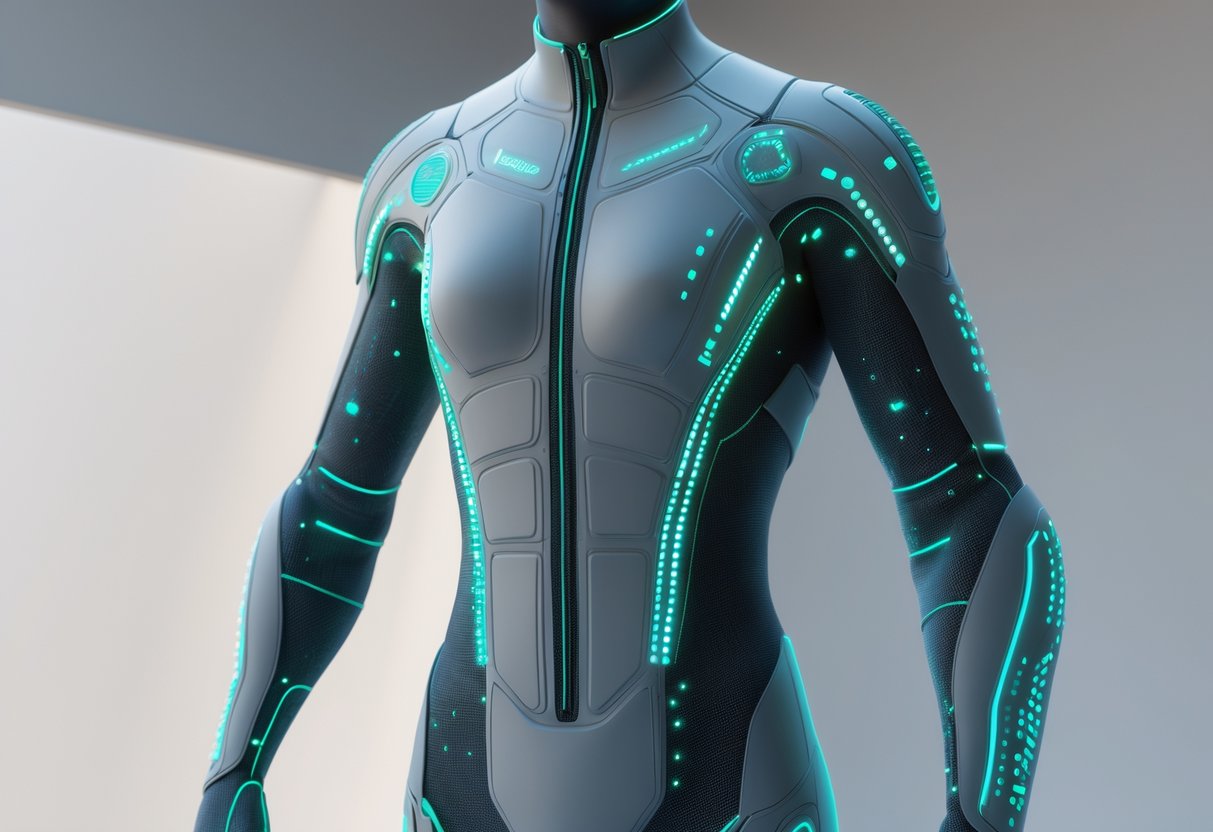
Haptic suits use different types of stimulation to create lifelike sensations, so safety is a big deal. You need to know about electrical risks, medical issues, and hygiene before jumping in.
Electrical Safety
Modern haptic suits use several kinds of electrical stimulation and you need to handle them with care. EMS (Electrical Muscle Stimulation) can make your muscles contract, while TENS (Transcutaneous Electrical Nerve Stimulation) gives a gentler touch.
Always check the voltage before using a suit. Most consumer models stay under 50 volts, which is considered safe. Still, damaged wires or moisture can turn things dangerous fast.
Key electrical safety tips:
- Don’t use suits with exposed wires or broken connectors
- Keep everything dry
- Check batteries and charging ports often
- Stick to the manufacturer’s power settings
- Only use approved chargers and cables
FES (Functional Electrical Stimulation) in advanced suits deserves extra caution. Those pulses can make muscles move on their own. Start with the lowest settings and work up slowly.
Store electronics in dry places. Swap out any damaged parts right away—don’t try to fix them yourself.
Medical Contraindications
Some medical conditions make haptic suits unsafe. If you have a pacemaker, never use EMS or TENS-based systems. The electrical signals can mess with your heart device.
Pregnant users need to be extra careful with electrical stimulation. Most companies say to avoid haptic suits during pregnancy, especially if there’s abdominal stimulation.
Other contraindications:
- Active epilepsy or seizure disorders
- Open wounds where the suit touches
- Recent surgery or implants
- Serious heart problems or arrhythmias
- Metal implants near where the suit stimulates
If you’re on blood thinners, talk to your doctor first. The feedback can sometimes cause light bruising.
Chronic pain conditions like fibromyalgia might get worse with haptic feedback. Some people are just more sensitive to touch or pressure.
Always read the medical warnings in the manual. If you’re unsure, check with your doctor before trying a suit.
Skin Contact and Hygiene
Direct skin contact creates hygiene risks that you can’t ignore. Haptic suits hold in sweat and heat, which is perfect for bacteria. Shared suits at gaming centers or events are especially risky.
Wipe down all contact areas after every use. Use antibacterial wipes on electrodes, padding, and fabric. Let everything dry completely before putting it away to keep mold and bacteria away.
Personal hygiene steps:
- Shower before long sessions to get rid of oils and germs
- Wear clean, dry clothes underneath if you can
- Only use conductor gel on clean skin
- Take the suit off right after you’re done
- Wash skin contact areas with soap and water afterward
Swap out disposable electrodes every session. Reusing them ups your risk of infection and makes them less effective.
Store suits somewhere airy between uses. UV sanitizers can help kill bacteria and viruses on fabrics. Never share suits without a proper cleaning between users.
If you have sensitive skin, test a small area first. Some people get rashes from synthetic materials or gels.
Applications and Use Cases
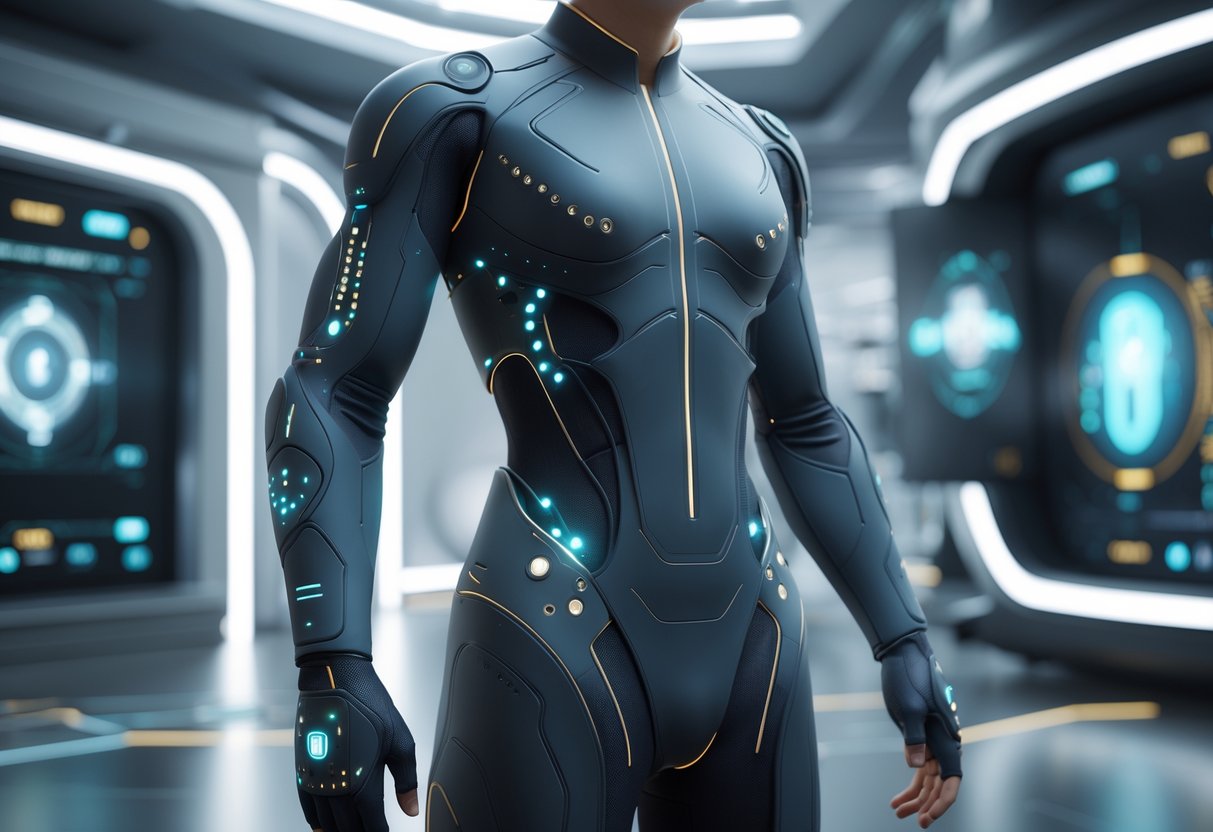
Haptic suits bring the sense of touch to digital worlds—gaming, training, even therapy. The tech changes how we connect with virtual spaces by making feedback feel real.
Virtual Reality Gaming
Gaming is probably the most exciting use for haptic suits. These devices let you actually feel explosions, gunshots, and impacts while you play.
Studies say player engagement jumps by 30% when haptic suits add tactile feedback. Games built for haptics create a stronger emotional bond between you and the virtual world.
Popular gaming uses:
- Shooters with real-feel weapon recoil
- Adventure games with interactive environments
- Racing sims with crash sensations
- Fighting games with punch and kick feedback
Companies like bHaptics design suits just for gaming. Their software works with big-name titles to deliver feedback at just the right moment.
The suits use accelerometers and gyros to track your movements. This info triggers motors or actuators that match what’s happening in the game.
Training and Simulation
Haptic suits are a game-changer for military and professional training. Trainees practice dangerous situations safely but still get realistic physical sensations.
Research shows haptic training cuts real-world errors by 35%. The tech helps build muscle memory without any real danger.
Key training uses:
- Military combat simulations
- Emergency response drills
- Equipment operation practice
- Safety procedure rehearsals
Organizations use haptic suits to prep workers for high-risk jobs. The feedback helps trainees understand the physical results of their choices.
Training software connects with simulation platforms to deliver the right sensations. Users feel equipment vibrations, environmental hazards, and physical contact during practice.
Rehabilitation and Therapy
More and more, medical professionals are turning to haptic feedback suits for patient rehab. This tech gives patients controlled physical stimulation right in their therapy sessions.
People recovering from injuries get real-time movement feedback. These suits retrain muscle memory and coordination with targeted sensations.
Therapeutic applications include:
- Stroke recovery programs
- Physical therapy exercises
- Balance and coordination training
- Pain management techniques
Healthcare software tracks patient progress with built-in sensors. Therapists tweak feedback intensity to match each person’s recovery pace.
The suits let patients practice movements in safe environments. Controlled feedback can rebuild confidence in physical abilities.
Entertainment and Media
Entertainment venues have started using haptic suits to create immersive experiences that go way beyond standard gaming. Theme parks and experience centers offer visitors some pretty unique tactile adventures.
Cinema and media companies are playing around with haptic feedback for more engaging storytelling. Viewers actually feel environmental effects and dramatic moments during films.
Entertainment uses include:
- Theme park attractions
- Interactive cinema experiences
- Museum exhibits
- Art installations
Content creators now build specialized software for these entertainment uses. The tech syncs with audio and visuals, aiming for a complete sensory experience.
Visitors usually report about 40% higher satisfaction when haptic feedback joins visual entertainment. The tech really turns passive watching into active participation.
Power and Connectivity
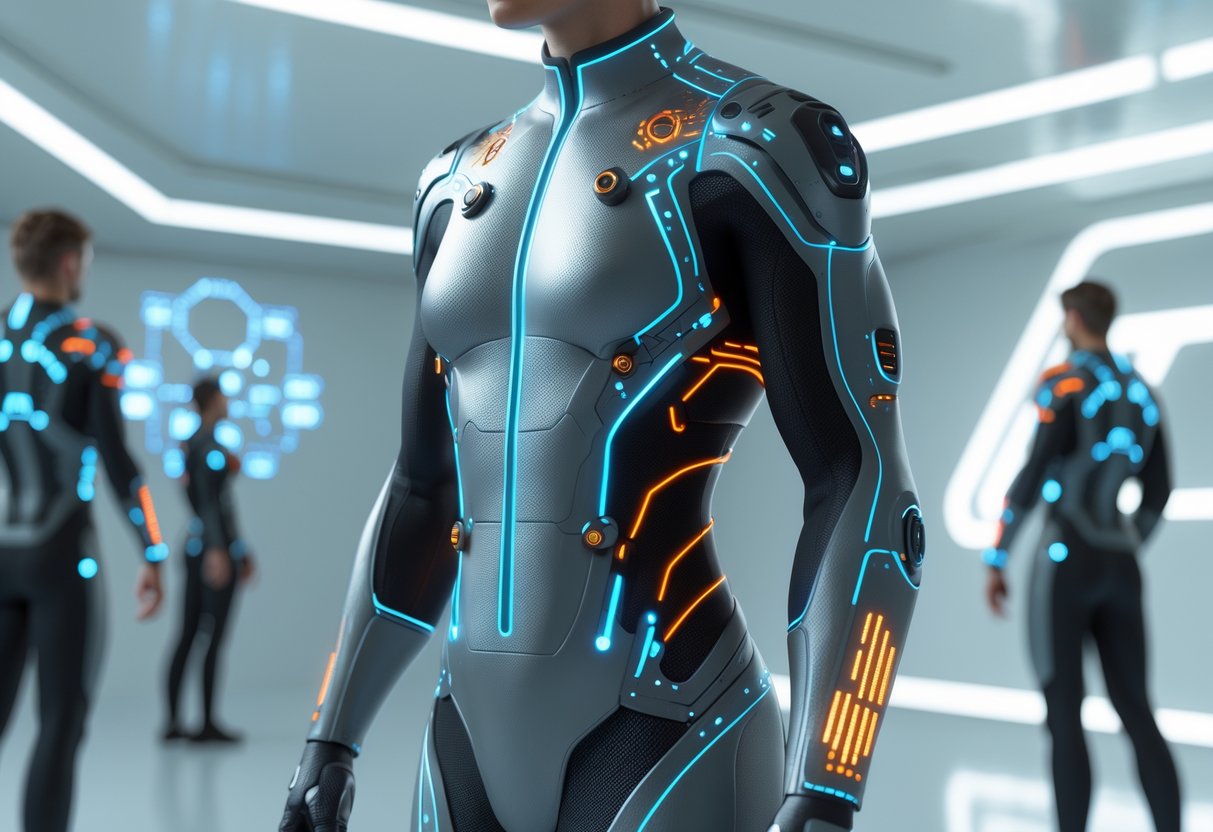
Haptic suits need solid power systems and flexible connection options to keep up with long gaming sessions. Most modern suits let you go wireless or wired, with battery life ranging from 5 to 13 hours, depending on how hard you push them.
Battery Life and Requirements
Battery performance varies a lot between different suits and how you use them. The bHaptics TactSuit X40, for example, can run for up to 13.5 hours straight if you crank every feedback point to max. Most folks will get much longer playtime in typical use.
Most suits rely on rechargeable lithium-ion batteries. The TactSuit X40 comes with a 9800mAh battery (35.574Wh) and charges in about 5 hours with a standard 5V 2A adapter.
Power consumption depends on things like:
- How many feedback points you use
- Intensity levels during play
- Wired or wireless connection
- Game-specific haptic demands
It’s smart to charge your suit overnight before those marathon sessions. Many users say they get 8-12 hours of regular gameplay before needing a recharge.
Wireless and Wired Options
Dual connectivity gives you options for any gaming setup. Most haptic suits support both Bluetooth Low Energy (BLE) and 3.5mm audio jack connections.
Bluetooth means you can go wireless, though you might notice a tiny bit of latency. For most VR games, that’s not a big deal.
Wired connections bring some perks:
- No latency at all
- No battery drain while playing
- A more stable connection
- Audio-to-haptic conversion
You can plug the 3.5mm audio jack straight into your headset or controller. This setup turns game audio into haptic feedback, which works even for games without built-in haptic support.
Connectivity with Other Devices
Cross-platform compatibility makes sure haptic suits work on lots of gaming systems. Modern suits support PC VR via SteamVR, standalone headsets like Meta Quest, and even console systems like PSVR.
Platform-specific features:
- Meta Quest: Native app support and wired audio-to-haptic
- PC VR (SteamVR): Native integration with 250+ games
- Console systems: Mostly audio-to-haptic conversion
Advanced suits like the TESLASUIT add motion capture and biometric sensors. These features connect your movements and physical responses directly to the virtual world.
Quick tip: Always check if your gaming platform works with the suit before buying to avoid headaches later.
Cost and Availability

Haptic feedback suits start at around £300 and can go up to £3,000, depending on features and motor count. Most consumer models are available from VR retailers and manufacturer sites, with worldwide shipping.
Current Market Prices
Entry-level haptic vests typically cost between £300 and £500. The bHaptics TactSuit Pro, featuring 32 feedback points, usually lands in the £400-600 range.
Mid-range options like the TactSuit X40, which has 40 motors, cost about £700-900. These models offer wireless connections and work across platforms.
Premium suits from brands like Teslasuit can hit £2,000-3,000. These come with extras like biometric tracking and temperature feedback.
Quick comparison:
- Basic vests (16-20 motors): £300-450
- Mid-range (32-40 motors): £500-900
- Professional grade: £1,500-3,000+
Most companies offer a 45-day money-back guarantee. You’ll usually pay for return shipping yourself.
Buying Considerations
Check game compatibility before spending your money. Over 300 VR games now support haptic feedback natively.
Think about your play style. If you’re super active, look for anti-slip materials and a secure fit. Racing sim fans will want precise recoil feedback.
Battery life matters if you plan to play wirelessly. Most suits give you 6-10 hours per charge.
Warning: Avoid suits with fewer than 16 feedback points. They just don’t feel immersive.
Size adjustability is important. Most suits claim “one-size-fits-all,” but double-check weight limits and chest measurements.
Audio-to-haptic features let you feel feedback in any content, even games that don’t support haptics natively.
Where to Purchase
Buy directly from brands like bHaptics or Teslasuit for full warranty and better support.
VR retailers like Knoxlabs offer competitive pricing and bundles. They carry several brands for easy comparison.
Amazon and other online shops might ship faster in some regions. Always check seller ratings and return policies.
Steer clear of marketplace sellers with suspiciously low prices. Fake haptic suits often have poor motor calibration.
Most manufacturers ship worldwide, but look up import duties for your country. EU buyers usually skip extra fees when buying from European distributors.
Future Trends in Haptic Suits

Haptic suits are shifting from gaming novelties to real tools in tons of industries. We’re seeing big leaps in sensor tech, lighter materials, and wireless features—these suits feel more comfortable and precise than ever.
Advancements in Technology
Next-gen haptic suits will use much smaller actuators for sharper feedback. Companies are rolling out wireless systems that ditch bulky cables, making movement feel natural whether you’re gaming or training.
New sensor tech brings pressure-sensitive materials that notice even the lightest touches. They react in milliseconds, so you can feel virtual objects or even weapon recoil.
Battery life is getting better fast. While current suits last 2-3 hours, newer models promise 8+ hours of play. Quick-charging will cut down waiting between sessions.
Improvements coming by 2026:
- Temperature simulation, not just vibration
- Individual finger tracking with haptic gloves
- Full-body suits under 2kg
- Voice-activated feedback controls
Machine learning will personalize haptic responses. The suit learns what you like and changes feedback intensity on its own. Explosions might feel different for each player, based on their comfort.
Potential for Mainstream Adoption
Gamers are still driving haptic suit sales, but prices are dropping fast. Basic vests now cost £300-500, way down from £2,000 a few years ago.
Big gaming companies are adding haptic support to popular titles. Fortnite and Call of Duty already have basic haptic feedback, and more games will follow.
Console makers are exploring haptic partnerships. Expect announcements about haptic-ready gaming systems in the next couple of years. Haptic suits could become as common as gaming headsets.
Price predictions for mainstream models:
| Year | Basic Vest | Full Suit |
|---|---|---|
| 2025 | £400 | £1,200 |
| 2027 | £200 | £600 |
| 2030 | £100 | £300 |
Rental services are popping up at gaming cafés and VR arcades. Players can try haptic suits before buying, making it easier to get started.
Expanding Use in Everyday Life
Medical training programs are picking up haptic suits quickly. Student doctors practice procedures with realistic touch feedback, which has cut real-world errors by 35%.
Fitness applications are growing past games. Haptic suits can simulate resistance, guide yoga poses, and give feedback during workouts. Home fitness programs with haptic suits are set to launch in 2026.
Remote work is opening new doors too. Engineers can “feel” mechanical parts during virtual design. Architects walk through buildings and sense different materials.
Education is testing haptic suits for immersive learning. History students feel the weight of medieval armor. Science students experience molecular interactions through touch.
Therapy and rehabilitation are huge growth areas. Stroke patients use haptic feedback to relearn motor skills. PTSD therapy benefits from controlled exposure with realistic sensations.
Heads up: Some companies make big promises about haptic features. Stick with established brands like bHaptics, HaptX, or SenseGlove for solid performance.
Frequently Asked Questions
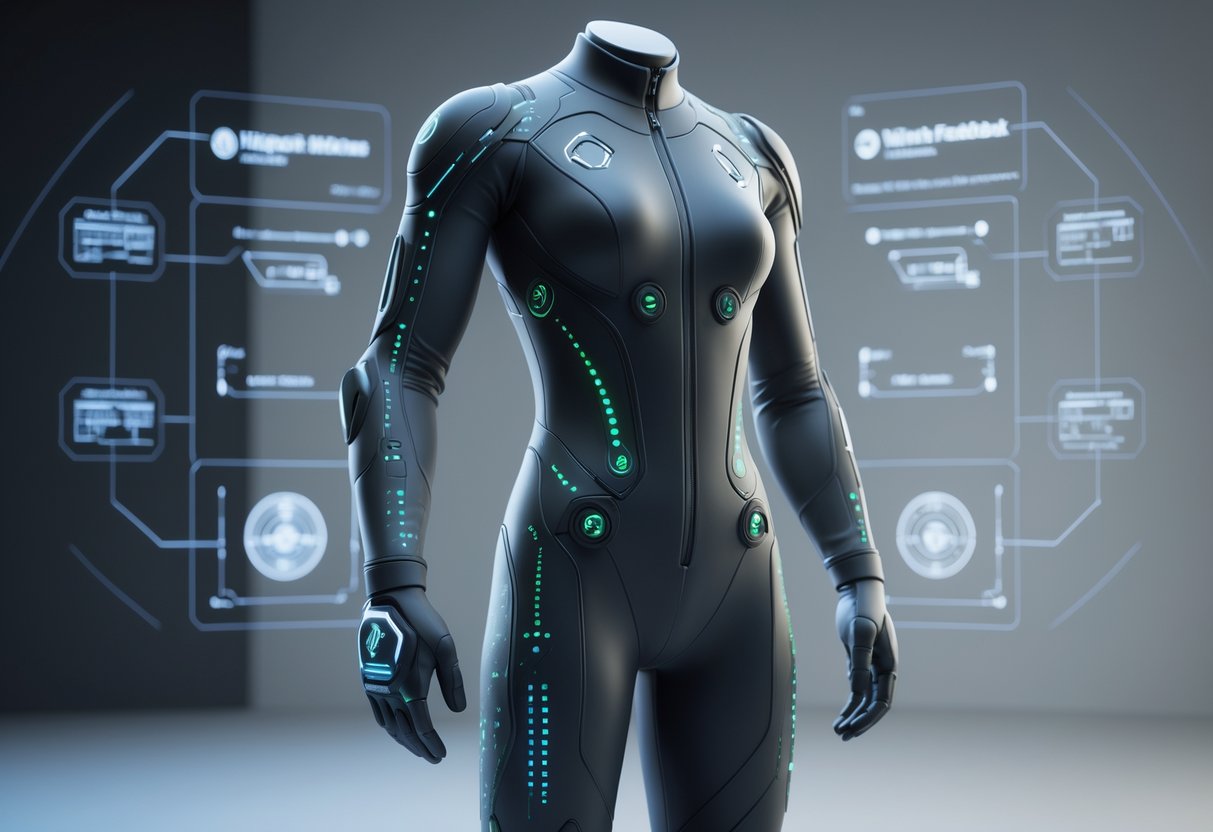
People always want to know how haptic suits work, which models fit their needs, and what to expect when buying their first one. Here are the questions we hear most from VR gamers ready to add touch feedback to their experience.
What are the best haptic vests currently available for immersive VR experiences?
The bHaptics TactSuit X is a top pick for most users. It’s got 48 actuators across the chest, back, arms, and legs, works with 100+ VR games, and costs around £500.
The TeslaSuit comes with premium features like temperature control and 50+ actuators, but it’s pricey—several thousand pounds—and needs powerful hardware.
If you’re on a budget, the TrueGear haptic vest delivers decent feedback for under £400. It supports 80+ Steam VR games, including Beat Saber and Half-Life: Alyx.
Can you recommend a full body haptic suit compatible with the Oculus Quest 2?
The bHaptics TactSuit X works well with Quest 2 headsets. You’ll need to connect it to a PC running VR software that supports haptic feedback. Lots of top Quest games have PC versions with haptic support.
The EXO Suit also pairs with Quest 2. It uses 16 actuators and 12 air bladders for realistic touch feedback. It costs about £1,500 and is lighter than most full-body suits.
Quick tip: Always check the suit’s compatibility list before buying. Not every VR game supports haptic feedback yet.
How do haptic feedback suits enhance virtual reality gaming?
Haptic suits let you actually feel what’s happening in VR games. When you get shot, you feel the impact. When you grab objects, you sense their weight and texture.
This touch feedback makes games way more immersive. You’re not just seeing and hearing the virtual world—you’re feeling it too. Many gamers say it helps them react faster in competitive games.
The suits use vibration, pressure, and sometimes temperature changes. Each game triggers different sensations, depending on what’s happening in the virtual environment.
Are there any haptic suits offering integration for the latest Oculus Quest 3?
Most current haptic suits connect with Quest 3 through a PC. The bHaptics TactSuit X supports Quest 3 games when you play through Steam VR or Oculus Link.
TrueGear recently announced Quest 3 compatibility for several big titles. Their suit uses wireless modules to talk to the headset.
Heads up: Direct Quest 3 integration is still pretty limited. Most suits need a PC to handle feedback signals.
What should you consider when purchasing a haptic suit for the first time?
Start with your budget and available space. Entry-level vests run £300-500, while full-body suits can go over £3,000. Make sure you’ve got enough room to move safely in the suit.
Check which games the suit supports. Some work with dozens of titles, others just a few. Look for compatibility with games you already own or want to buy.
Comfort and fit matter a lot. You might wear the suit for hours. Look for adjustable straps, breathable fabrics, and reasonable weight. User reviews can tell you a lot about long-term comfort.
Think about your VR setup. Some suits need a powerful PC, special software, or extra hardware to work right.
Could you list the differences between the Owo and Tesla haptic suits?
The OWO suit keeps things light and wireless. It creates sensations using electrical stimulation and weighs less than 500 grams.
You’ll find the OWO costs somewhere around £400-600.
Tesla suits, on the other hand, use mechanical actuators and even offer temperature feedback. They deliver stronger sensations, but you’ll definitely notice the extra weight—several kilograms, actually.
Tesla suits come with a much higher price tag, usually over £5,000. They’re mostly aimed at professional training rather than casual use.
You can use OWO suits with mobile apps, and they don’t demand a powerful computer. Tesla suits need high-end PCs and some pretty specialized software to work right.
Tesla covers more of your body with detailed feedback zones. OWO keeps it simple and sticks to core areas, offering basic on/off sensations.

